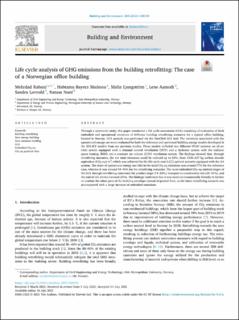| dc.contributor.author | Rabani, Mehrdad | |
| dc.contributor.author | Madessa, Habtamu Bayera | |
| dc.contributor.author | Ljungström, Malin | |
| dc.contributor.author | Aamodt, Lene | |
| dc.contributor.author | Løvvold, Sandra | |
| dc.contributor.author | Nord, Natasa | |
| dc.coverage.spatial | Norway | en_US |
| dc.date.accessioned | 2021-09-28T07:36:43Z | |
| dc.date.available | 2021-09-28T07:36:43Z | |
| dc.date.created | 2021-07-18T18:32:50Z | |
| dc.date.issued | 2021-07-16 | |
| dc.identifier.issn | 0360-1323 | |
| dc.identifier.uri | https://hdl.handle.net/11250/2783920 | |
| dc.description.abstract | Through a systematic study, this paper conducted a life cycle assessment (LCA) consisting of evaluation of both embodied and operational emissions of different building retrofitting scenarios for a typical office building, located in Norway. LCA analysis was performed via the OneClick LCA tool. The emissions associated with the operational energy use were evaluated for both the reference and optimized building energy models developed in the IDA-ICE models from our previous studies. These models included two different HVAC systems: an all-air (AA) system equipped with a demand control ventilation (DCV) and a hydronic system with the radiator space heating (RSH) and a constant air volume (CAV) ventilation system. The findings showed that, through retrofitting measures, the net total emissions could be reduced up to 52%, from 1336–637 kg carbon dioxide equivalent (CO2-eq)/m2, which was achieved for the life cycle cost (LCC) optimal scenario equipped with the AA system. The share of operational energy use (B6) in the total CO2-eq emissions was around 77% for the reference case, whereas it was around 43–46% for the retrofitting scenarios. The most embodied CO2-eq emitted stages of the LCA through retrofitting concerned the product stage (19–23%), transport to construction site (24–31%), and the end-of-life service (around 25%). The findings confirmed that it was more environmentally friendly to further re-insulate the other parts of the building envelope instead of ground floor, as the latter retrofitting scenario was accompanied with a large increase of embodied emissions. | en_US |
| dc.language.iso | eng | en_US |
| dc.publisher | Elsevier | en_US |
| dc.relation.ispartofseries | Building and Environment;Volume 204, 15 October 2021, 108159 | |
| dc.rights | Navngivelse 4.0 Internasjonal | * |
| dc.rights.uri | http://creativecommons.org/licenses/by/4.0/deed.no | * |
| dc.subject | Building retrofitting | en_US |
| dc.subject | Zero energy building | en_US |
| dc.subject | Zero emission building | en_US |
| dc.subject | Life cycle assessments | en_US |
| dc.subject | LCA | en_US |
| dc.subject | Embodied CO2-eq | en_US |
| dc.subject | CO2-eq payback times | en_US |
| dc.title | Life cycle analysis of GHG emissions from the building retrofitting: The case of a Norwegian office building | en_US |
| dc.type | Peer reviewed | en_US |
| dc.type | Journal article | en_US |
| dc.description.version | publishedVersion | en_US |
| dc.rights.holder | © 2021 The Authors. | en_US |
| dc.source.articlenumber | 108159 | en_US |
| cristin.ispublished | false | |
| cristin.fulltext | postprint | |
| cristin.qualitycode | 2 | |
| dc.identifier.doi | https://doi.org/10.1016/j.buildenv.2021.108159 | |
| dc.identifier.cristin | 1922034 | |
| dc.source.journal | Building and Environment | en_US |
| dc.source.volume | 204 | en_US |
| dc.source.pagenumber | 1-16 | en_US |

